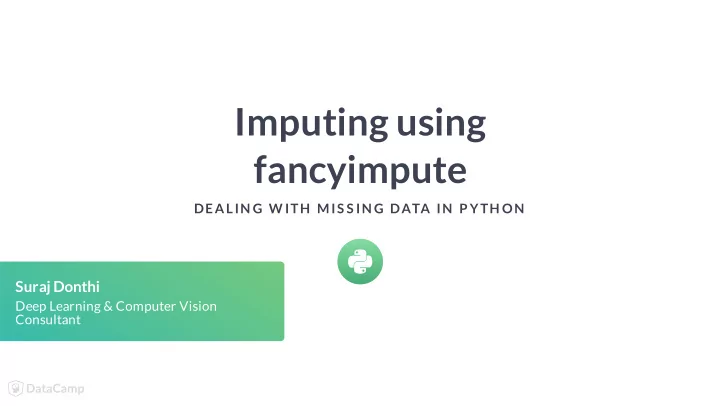

Imputing using fancyimpute DEALIN G W ITH MIS S IN G DATA IN P YTH ON Suraj Donthi Deep Learning & Computer Vision Consultant
fancyimpute package Package contains advanced techniques Uses machine learning algorithms to impute missing values Uses other columns to predict the missing values and impute them DEALING WITH MISSING DATA IN PYTHON
Fancyimpute imputation techniques KNN or K-Nearest Neighbor MICE or Multiple Imputation by Chained Equations DEALING WITH MISSING DATA IN PYTHON
K-Nearest Neighbor Imputation Select K nearest or similar data points using all the non-missing features T ake average of the selected data points to �ll in the missing feature DEALING WITH MISSING DATA IN PYTHON
K-Nearest Neighbor Imputation from fancyimpute import KNN knn_imputer = KNN() diabetes_knn = diabetes.copy(deep=True) diabetes_knn.iloc[:, :] = knn_imputer.fit_transform(diabetes_knn) DEALING WITH MISSING DATA IN PYTHON
Multiple Imputations by Chained Equations (MICE) Perform multiple regressions over random sample of the data T ake average of the multiple regression values Impute the missing feature value for the data point DEALING WITH MISSING DATA IN PYTHON
Multiple Imputations by Chained Equations(MICE) from fancyimpute import IterativeImputer MICE_imputer = IterativeImputer() diabetes_MICE = diabetes.copy(deep=True) diabetes_MICE.iloc[:, :] = MICE_imputer.fit_transform(diabetes_MICE) DEALING WITH MISSING DATA IN PYTHON
Summary Using Machine Learning techniques to impute missing values KNN �nds most similar points for imputing MICE performs multiple regression for imputing MICE is a very robust model for imputation DEALING WITH MISSING DATA IN PYTHON
Let's practice! DEALIN G W ITH MIS S IN G DATA IN P YTH ON
Imputing categorical values DEALIN G W ITH MIS S IN G DATA IN P YTH ON Suraj Donthi Deep Learning & Computer Vision Consultant
Complexity with categorical values Most categorical values are strings Cannot perform operations on strings Necessity to convert/encode strings to numeric values and impute DEALING WITH MISSING DATA IN PYTHON
Conversion techniques ONE-HOT ENCODER ORDINAL ENCODER Color Color_Red Color_Green Color_Blue Color Value Red 1 0 0 Red 0 Green 0 1 0 Green 1 Blue 0 0 1 Blue 2 Red 1 0 0 Red 0 Blue 0 0 1 Blue 2 Blue 0 0 1 Blue 2 DEALING WITH MISSING DATA IN PYTHON
Imputation techniques Fill with most frequent category Impute using statistical models like KNN DEALING WITH MISSING DATA IN PYTHON
Users pro�le data users = pd.read_csv('userprofile.csv') users.head() smoker drink_level dress_preference ambience hijos activity budg 0 False abstemious informal family independent student medi 1 False abstemious informal family independent student low 2 False social drinker formal family independent student low 3 False abstemious informal family independent professional medi 4 False abstemious no preference family independent student medi DEALING WITH MISSING DATA IN PYTHON
Ordinal Encoding from sklearn.preprocessing import OrdinalEncoder # Create Ordinal Encoder ambience_ord_enc = OrdinalEncoder() # Select non-null values in ambience ambience = users['ambience'] ambience_not_null = ambience[ambience.notnull()] reshaped_vals = ambience_not_null.values.reshape(-1, 1) # Encode the non-null values of ambience encoded_vals = ambience_ord_enc.fit_transform(reshaped_vals) # Replace the ambience column with ordinal values users.loc[ambience.notnull(), 'ambience'] = np.squeeze(encoded_vals) DEALING WITH MISSING DATA IN PYTHON
Ordinal Encoding # Create dictionary for Ordinal encoders ordinal_enc_dict = {} # Loop over columns to encode for col_name in users: # Create ordinal encoder for the column ordinal_enc_dict[col_name] = OrdinalEncoder() # Select the nin-null values in the column col = users[col_name] col_not_null = col[col.notnull()] reshaped_vals = col_not_null.values.reshape(-1, 1) # Encode the non-null values of the column encoded_vals = ordinal_enc_dict[col_name].fit_transform(reshaped_vals) DEALING WITH MISSING DATA IN PYTHON
Imputing with KNN users_KNN_imputed = users.copy(deep=True) # Create MICE imputer KNN_imputer = KNN() users_KNN_imputed.iloc[:, :] = np.round(KNN_imputer.fit_transform(imputed)) for col in imputed: reshaped_col = imputed[col].values.reshape(-1, 1) users_KNN_imputed[col] = ordinal_enc[col].inverse_transform(reshaped_col) DEALING WITH MISSING DATA IN PYTHON
Summary Steps to impute categorical values Convert non-missing categorical columns to ordinal values Impute the missing values in the ordinal DataFrame Convert back from ordinal values to categorical values DEALING WITH MISSING DATA IN PYTHON
Let's practice! DEALIN G W ITH MIS S IN G DATA IN P YTH ON
Evaluation of different imputation techniques DEALIN G W ITH MIS S IN G DATA IN P YTH ON Suraj Donthi Deep Learning & Computer Vision Consultant
Evaluation techniques Imputations are used to improve model Density plots explain the distribution in the performance. data. Imputation with maximum machine learning A very good metric to check bias in the model performance is selected. imputations. DEALING WITH MISSING DATA IN PYTHON
Fit a linear model for statistical summary import statsmodels.api as sm diabetes_cc = diabetes.dropna(how='any') X = sm.add_constant(diabetes_cc.iloc[:, :-1]) y = diabetes_cc['Class'] lm = sm.OLS(y, X).fit() DEALING WITH MISSING DATA IN PYTHON
print(lm.summary()) Summary: OLS Regression Results ============================================================================== Dep. Variable: Class R-squared: 0.346 Model: OLS Adj. R-squared: 0.332 Method: Least Squares F-statistic: 25.30 Date: Wed, 10 Jul 2019 Prob (F-statistic): 2.65e-31 Time: 15:03:19 Log-Likelihood: -177.76 No. Observations: 392 AIC: 373.5 Df Residuals: 383 BIC: 409.3 Df Model: 8 Covariance Type: nonrobust ===================================================================================== coef std err t P>|t| [0.025 0.975] <hr />---------------------------------------------------------------------------------- const -1.1027 0.144 -7.681 0.000 -1.385 -0.820 Pregnant 0.0130 0.008 1.549 0.122 -0.003 0.029 Glucose 0.0064 0.001 7.855 0.000 0.005 0.008 Diastolic_BP 5.465e-05 0.002 0.032 0.975 -0.003 0.003 Skin_Fold 0.0017 0.003 0.665 0.506 -0.003 0.007 Serum_Insulin -0.0001 0.000 -0.603 0.547 -0.001 0.000 BMI 0.0093 0.004 2.391 0.017 0.002 0.017 Diabetes_Pedigree 0.1572 0.058 2.708 0.007 0.043 0.271 Age 0.0059 0.003 2.109 0.036 0.000 0.011 DEALING WITH MISSING DATA IN PYTHON
R-squared and Coef�cients lm.rsquared_adj 0.33210 lm.params const -1.102677 Pregnant 0.012953 Glucose 0.006409 Diastolic_BP 0.000055 Skin_Fold 0.001678 Serum_Insulin -0.000123 BMI 0.009325 Diabetes_Pedigree 0.157192 Age 0.005878 dtype: float64 DEALING WITH MISSING DATA IN PYTHON
Fit linear model on different imputed DataFrames # Mean Imputation X = sm.add_constant(diabetes_mean_imputed.iloc[:, :-1]) y = diabetes['Class'] lm_mean = sm.OLS(y, X).fit() # KNN Imputation X = sm.add_constant(diabetes_knn_imputed.iloc[:, :-1]) lm_KNN = sm.OLS(y, X).fit() # MICE Imputation X = sm.add_constant(diabetes_mice_imputed.iloc[:, :-1]) lm_MICE = sm.OLS(y, X).fit() DEALING WITH MISSING DATA IN PYTHON
Comparing R-squared of different imputations print(pd.DataFrame({'Complete': lm.rsquared_adj, 'Mean Imp.': lm_mean.rsquared_adj, 'KNN Imp.': lm_KNN.rsquared_adj, 'MICE Imp.': lm_MICE.rsquared_adj}, index=['R_squared_adj'])) Complete Mean Imp. KNN Imp. MICE Imp. R_squared_adj 0.332108 0.313781 0.316543 0.317679 DEALING WITH MISSING DATA IN PYTHON
Recommend
More recommend